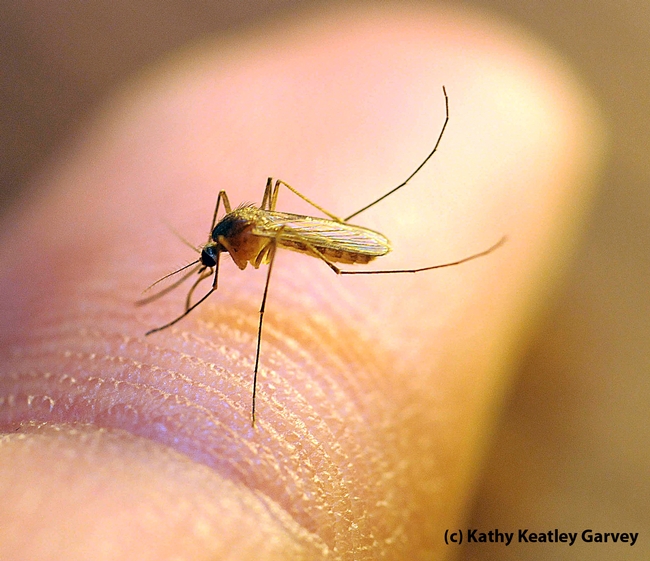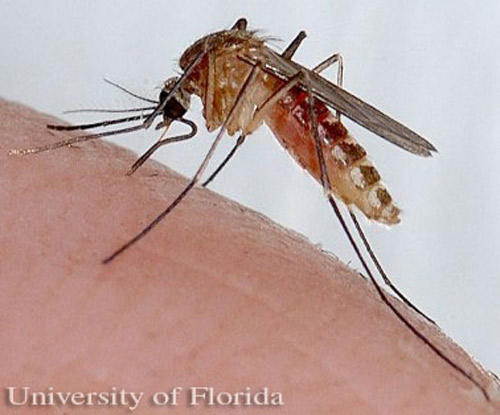Zanzara Culex quinquefasciatusla classica zanzara rompicoglioni
Zanzara Culex quinquefasciatus




Culex quinquefasciatus
From Wikipedia, the free encyclopedia
Culex quinquefasciatus
Culex quinquefasciatus E-A-Goeldi 1905.jpg
Left: male, right: female
Scientific classification
Kingdom: Animalia
Phylum: Arthropoda
Class: Insecta
Order: Diptera
Family: Culicidae
Genus: Culex
Species: C. quinquefasciatus
Binomial name
Culex quinquefasciatus
Say, 1823
Culex quinquefasciatus (earlier known as Culex fatigans), the southern house mosquito, is a medium-sized mosquito found in tropical and subtropical regions of the world. It is the vector of Wuchereria bancrofti, avian malaria, and arboviruses including St. Louis encephalitis virus, Western equine encephalitis virus, and West Nile virus.[1] It is taxonomically regarded as a member of the Culex pipiens species complex.[2] Its genome was sequenced in 2010, and was shown to have 18,883 protein-coding genes.[3]
Contents
1 Description
2 Life cycle
3 As a vector
4 Bionomics
5 References
6 External links
Description
Adult Culex quinquefasciatus is a medium-sized mosquito and is brown in colour. The body is about 3.96 to 4.25 mm long. While the main body is brown, the proboscis, thorax, wings, and tarsi are darker than the rest of the body. The head is light brown with the lightest portion in the center. The antennae and the proboscis are about the same length, but in some cases the antennae are slightly shorter than the proboscis. The flagellum has thirteen segments that may have few or no scales. The scales of the thorax are narrow and curved. The abdomen has pale, narrow, rounded bands on the basal side of each tergite. Males can be differentiated from females in having large palps and feathery antennae.[4]
The larva has a short and stout head. The mouth brushes have long yellow filaments that are used for filtering organic materials. The abdomen consists of eight segments, the siphon, and the saddle. Each segment has a unique setae pattern. The siphon is on the dorsal side of the abdomen, and is four times longer than its breadth. The siphon has multiple setae tufts. The saddle is barrel-shaped and located on the ventral side of the abdomen with four long anal papillae protruding from the posterior end.[1]
Life cycle
Mature Culex quinquefasciatus females fly at night to nutrient-rich standing water to lay eggs. The larvae feed on organic material in the water and require between five to eight days to complete their development at 30°C. The larvae pass through four larval instars, and towards the end of the fourth instar they stop eating and undergo moulting to give rise to pupae. After 36 hours at 27°C adults emerge. The exact timing of development can vary depending on temperature. Both males and females take sugar meals from plants. But after mating, the female seeks a blood meal on mammals and birds. Ingested blood is necessary for egg development. A single female can lay up to five rafts of eggs in a lifetime, with each raft containing thousands of eggs. The exact number varies depending on climatic conditions.[1]
As a vector
Culex quinquefasciatus transmit zoonotic diseases that affect humans, wild and domestic animals, such as lymphatic filariasis, avian malaria, St. Louis encephalitis, Western equine encephalitis, and West Nile fever. It causes infection through biting during blood meal. In southern U.S. it is the primary vector of St. Louis encephalitis virus. In India and Southeast Asia, it is the primary vector of Wuchereria bancrofti, a nematode that causes lymphatic filariasis. It acts as an intermediate host for the helminth parasite by harbouring the larval stages.[5] It also transmits Plasmodium relictum, a malarial parasite of birds, and is the principal vector in Hawaii. It is the definitive host for malarial parasite as it harbours the sexual cycle.[6]
Bionomics
It breeds profusely in dirty water collections, including stagnant drains, cesspools, septic tanks with leak, burrow pits, and almost all organic polluted water collections. In optimum temperature and humidity, the life cycle will be completed in seven days, passing through the egg, larva, pupa and adult stages.
Lampadina gialla antizanzarehttp://www.mosquitoweb.it/Repellenti/lampa...ntizanzare.htmlDa qualche tempo sono in commercio lampadine di colore giallo che promettono di tenere lontane le zanzare. Esistono studi scientifici che ne dimostrano l'efficacia ma in pratica funzionano?
Ti sarà capitato di trovare in commercio lampade a basso consumo energetico di colore giallo con indicato sulla confezione il logo formato da una zanzara barrata, sinonimo di effetto antizanzara.
Si tratta di lampadine ricoperte di un pigmento giallo luminoso sulla parte interna del bulbo di vetro che viene utilizzato per schermare la radiazione UV. Quando sono accese emetteranno una luce con una lunghezza d'onda particolare (tra i 570-580 nm) che emette una luce di colore giallo che dovrebbe allontanare le zanzare.
La domanda sorge spontanea: Funziona? Ebbene si, esiste anche documentazione scientifica a riguardo.
Durante i test svolti presso la Malaysian Society of Parasitology and Tropical Medicine sono state utilizzate due specie di zanzara: la
Culex quinquefasciatus e la Aedes albopictus meglio conosciuta come zanzare tigre. L'effetto repellente della lampada verso le prime è stato un successo, la popolazione di zanzare è stata ridotta del 91,34%.
Non si sono notate differenze rilevanti invece con le zanzare tigre. Secondo gli scienziati il motivo potrebbe essere lo scarso numero di esemplari utilizzato durante i test dato che la cattura degli insetti e i test sono avvenuti durante la notte.
Le considerazioni sono comunque semplici da fare. La zanzara tigre è attiva durante il giorno, periodo nel quale una lampadina non produce variazioni sostanziali dell'illuminazione già presente. Quindi su questa specie di zanzara non mi aspetto che lampadine di questo tipo abbiamo effetto alcuno, tanto meno che abbia senso tenerle accese durante il giorno.
Discorso diverso durante la notte, periodo in cui sono attive le Culex, quando una luce con queste caratteristiche può rendere più piacevole restare all'aria aperta. La situazione ideale dove possono essere utilizzate può essere, per esempio, in un patio, in un gazebo dotato di illuminazione o semplicemebte su un balcone.
 http://www.mosquitoweb.it/mosquitoshop/115...re-philips.html
http://www.mosquitoweb.it/mosquitoshop/115...re-philips.html



